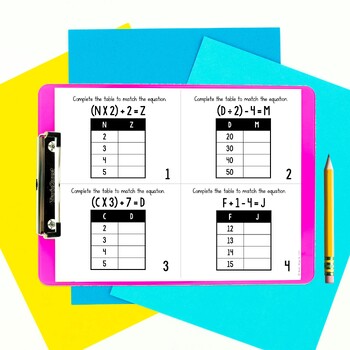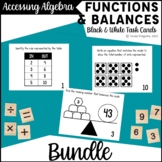Applying Two Step Rules in Function Tables - Input Output Tables Task Cards
- PDF
Also included in
- Accessing Algebra builds algebraic thinking through exploration of equations, function tables, patterns in numbers, and equality. Students write and apply one-step and two-step equations given models and data tables. By focusing on models and tables, these task cards feel like number and logic puzzlPrice $18.99Original Price $24.00Save $5.01
Description
These input/output task cards give students the opportunity to apply rules or patterns using any operation. Students apply the given two step rule to complete the function table. Variables are included in the given equations to help build the connection between dependent and independent variables in linear equations.
These task cards are a great connection between applying rules in elementary school and linear equations in middle school. By integrating algebraic concepts in elementary classrooms, students develop math reasoning and computation skills while applying number sense, logic, and algebraic thinking.
WHAT'S INCLUDED:
- 28 task cards
- Recording sheet
- answer key
Input/Output tables help students work with patterns and relationships between numbers. Function tables such as these help students understand that a variable stands for any unknown number, rather than just a specific missing number in an equation. So, rather than identifying the rule as x2 + 1, for example, it is identified with that variable and includes a variable as the solution.
I intentionally left these task cards and the recording sheet somewhat open ended. This allows you to tailor your directions to match your students’ readiness levels. You can duplicate the task cards for students to write on if you think they need the support. I’d recommend printing the PDF with more than one page to a page to save on paper. The answer key lists just the missing numbers from the output table, separated by commas. Students should be able to complete the recording sheet similarly after a quick explanation with an example.
If you have not worked with input/output tables previously, students will likely need some instruction for beginning. Once it’s introduced, these are a great extension for fast finishers, and even high ability students.
These task cards are great for:
- whole class instruction
- small group instruction- both guided or independent
- fast finisher extensions
- high ability extensions
These task cards are part of my Accessing Algebra line. Accessing Algebra is designed to focus on applying algebraic thinking with our existing standards, giving students the tools they'll need for success later. By looking at the standards in a new way, students build a deeper understanding of the standard while also building their critical and algebraic thinking.
Other Input/Output Tables Activities:
☆ Mixed Operations Input-Output Tables Task Cards - Applying Rules
☆ Mixed Operations Input-Output Tables Task Cards - Rules in Function Tables
☆ Two Step Rules in Function Tables - Input Output Tables Task Cards
Other Accessing Algebra Activities
★ Multiplication Facts Balancing Equations - Missing Factor Task Cards
★ Writing & Solving Multi Step Equations - Balancing Equations Task Cards
★ Writing & Solving Two Step Equations - Balancing Equations Task Cards
☆ Writing & Solving Two Step Equations to Models Task Cards
CLICK HERE to follow me and be notified of future products as soon as they are posted.
_______________________________________________________________
Copyright © Tessa Maguire.
Purchase is for single classroom use only. Please purchase additional licenses if you intend to share this product with colleagues.
You may not redistribute, edit, sell, or otherwise post this product on the internet. You may, however, post a link for others to purchase themselves.






